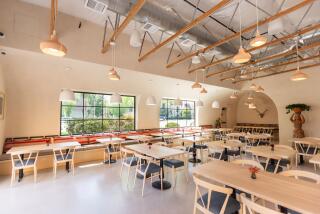The Research Restaurant On the Cal Poly Ranch
Here’s a nice little restaurant: Expansive view of the Pomona Valley, a hip California wine list, eager waiters bearing platters of grilled California-style food, liberally seasoned with herbs from the restaurant’s garden. The decor is a little on the angular/austere side, but that’s fashionable. And if you listen carefully, you can hear cattle lowing.
About those cattle. This particular restaurant, known as the Restaurant at Kellogg Ranch, is located at the agricultural end of the California Polytechnic University campus. The eager waiters--and the eager cooks, dishwashers and everybody else--are all college students.
The restaurant is in a brand new building--the James and Carole Collins Hospitality Center--perched on the highest hill in the Cal Poly campus. It boasts hotel and restaurant management study labs crammed with computers and several kitchens, including an auditorium/demonstration kitchen. The restaurant kitchen, visible in every detail through a huge window in the lobby, is impressively furnished.
However, this is not a cooking school; it’s part of Cal Poly’s Hotel and Restaurant Management Department. “Only about 5% of our students will go on to be line chefs,” observes the center’s director, Bob Small. “These kids are all planning to be managers.”
Cal Poly has offered a major in Hotel and Restaurant Management since 1973 and already boasts such well-known alumni as Mark Peel, co-owner of Campanile. But the Collins Hospitality Center adds a new dimension: From now on, every student who graduates in Hotel and Restaurant Management (total enrollment: 800) will have spent a quarter working in the restaurant doing everything from recipe development and menu planning down to grunge work such as dish washing. They switch off jobs every couple of days.
Obviously, this will give the students a much better understanding of what they’re managing when they’re, say, running a hotel. Requirements such as menu planning also give them invaluable practical experience in making management decisions.
“The story really begins 10 years ago,” says Small, “when I was an intern at Ma Maison. Patrick Terrail suggested there should be a hands-on school like this.” Small took the suggestion seriously, and over the years, as he got involved in teaching, he put together the backing that built the center.
He points out a wall honoring the dozens of benefactors: Coke, Marriott, Hilton, In and Out, Carl’s Jr. The largest benefactors, of course, are James and Carole Collins themselves, of Collins Food (which is Sizzler and Kentucky Fried Chicken). But chefs such as Piero Selvaggio of Valentino and Emilio Baglioni of Emilio’s have also helped out. The kitchen equipment, down to the salt shakers on the tables, was donated; the Hotel and Restaurant Management department has more computers per student than any other at Cal Poly, thanks to Hewlett-Packard.
“There’s no state money in this building,” Small says. “It was entirely funded by the food industry, and so we feel an obligation to serve the industry as well.”
For instance, one purpose of the facility is getting guest chefs to demonstrate restaurant equipment. The auditorium demonstration kitchen has a dispensation from the state law that such kitchens must have a hood; it’s testing a European alternative known as the ventilated ceiling--in place of a hood there are colander-like metal structures in the ceiling that can be thrown into the dishwasher when they get dirty.
Besides the restaurant kitchen there’s a separate kitchen where recipes are tested. Here also there is something for the industry as well as the students. Heat pumps and passive lighting are being tested. Meters monitor energy consumption of all the equipment for Southern California Edison.
“We may be a testing location for emissions from charbroilers for the Air Quality Management District,” adds Small. The AQMD headquarters are only three miles away. “We hope to become known for honest, objective testing.”
Might the AQMD outlaw restaurant charbroilers--not just the charcoal starter fluid used in backyard barbecues, as it did last week? He nods. “It’s possible. It might happen in as few as five years.”
No charbroiling? What will become of California Cuisine? Cal Poly holds California’s future in its hands.
More to Read
Eat your way across L.A.
Get our weekly Tasting Notes newsletter for reviews, news and more.
You may occasionally receive promotional content from the Los Angeles Times.









